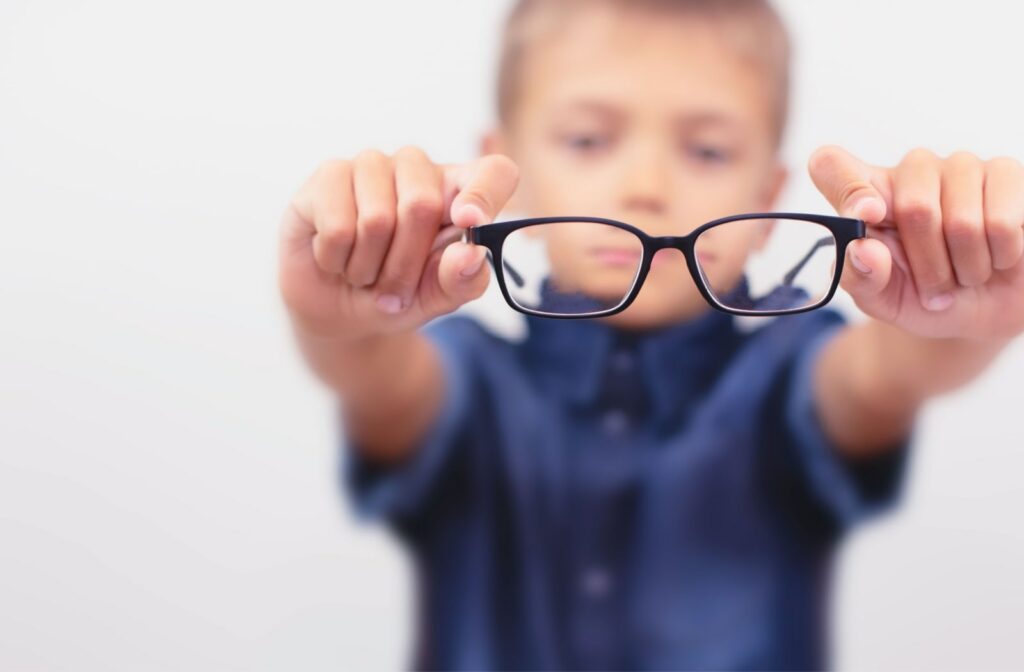As a parent of a child with myopia, you know all too well the worry and stress it can bring. Myopia not only presents challenges in terms of daily activities but can also put your children at risk for long-term vision issues if left untreated.
The good news is that there are simple steps you can take right now to help reduce the risk of further myopia progression and improve their quality of life—starting with myopia control!
Myopia control helps children see clearly and reduce their lifetime risk of developing myopia complications and other serious eye conditions like glaucoma and cataracts. Learning more about what myopia control is can help you fully understand how it can benefit your children.
Understanding Myopia & Its Causes
Myopia, commonly known as nearsightedness, is a refractive error that causes distant objects to appear blurry while nearby objects remain in focus.
The main cause of myopia is an elongated eyeball or a steeply curved cornea, which causes light rays to focus incorrectly in the eye. Genetics can play a role in the development of myopia, as children of nearsighted parents may be more likely to develop the condition as well.
Other factors that contribute to myopia include spending extended periods of time focusing on close-up tasks, such as reading or using electronic devices.
Understanding the causes of myopia can help individuals take steps to prevent or manage the condition, such as limiting screen time and getting regular eye exams.

Advantages of Myopia Control for Your Child’s Eye Health
As a parent, you always want what’s best for your child, especially when it comes to their health. When it comes to eye health, myopia is a common issue that affects many children. However, with the advancement of science and technology, myopia control is now a viable option to help slow its progression.
The advantages of myopia control go beyond just correcting vision. It can also reduce a child’s risk of developing serious eye diseases like glaucoma, cataracts, and retinal detachment later in life.
Additionally, it can improve your child’s overall quality of life by allowing them to enjoy activities without having to rely on corrective eyewear.
What Are the Different Types of Myopia Control?
Myopia control treatment methods include a range of different approaches that aim to slow the progression of myopia in children, including specialty contact lenses, eye drops, and multifocal lenses for glasses.
MiSight Lenses for Myopia Control
MiSight 1 day contact lenses are soft contact lenses with an increased plus power in the periphery, which can reduce the amount of peripheral retinal defocus associated with myopia. The lenses can be worn during the day and are replaced daily.
MiSight contacts have been shown to be effective at controlling myopia progression in clinical studies, and they offer additional benefits such as improved visual acuity—and improved convenience compared to traditional eyeglasses.
Orthokeratology for Myopia Control
Orthokeratology, often referred to as ortho-k, is a non-surgical procedure that involves the use of specially designed and fitted contact lenses. These lenses are worn during sleep to temporarily reshape the cornea, the clear front surface of the eye, thereby improving vision.
After removing ortho-k lenses in the morning, the wearer can typically see clearly throughout the day without the need for glasses or daytime contact lenses.
Atropine Eye Drops for Myopia Control
Atropine is a drug that relaxes the ciliary muscles and helps reduce the amount of near-focusing effort required to see up close, resulting in less stress on the eyes. In low concentrations, atropine eye drops can slow myopia progression in children from age 4.
Multifocal Eyeglasses
Multifocal eyeglasses have also shown promise in reducing the progression of myopia. There are several types of multifocal lenses, but MiYOSMART glasses lenses are one common option that can control myopia for kids using D.I.M.S. technology (defocus incorporated multiple segments).
The different segments of MiYOSMART lenses help control the way light enters the eye to promote clear vision and slow myopia progression.
With these options available, it’s important to consult an eye doctor to determine the right course of treatment for your specific myopia needs. By taking control of myopia today, you can help safeguard your child’s vision for the future.
How to Choose the Right Myopia Control Treatment for Your Child
With so many options available, it can be easy to become confused about what is best for your child. However, taking some time to research and understand your child’s unique needs can help you make an informed decision.
Consider factors such as the progression of your child’s myopia, potential side effects of treatment, and your child’s age and personality when assessing which treatment options may be the right choice.
It’s important to remember that every child is different, and what works for one may not work for another. Don’t hesitate to ask questions and voice your concerns. We can help you find the right myopia treatment plan for your child.
Finding the Solution to Myopia
Myopia can provide many challenges for parents and their children. Thankfully, there are multiple myopia control options and strategies that can promote healthy vision development and slow myopia progression.
While some treatment options, such as glasses or contact lenses, may be necessary for helping your child see clearly, it is also important to consider more specific myopia control treatments that can help your child maintain their eye health into adulthood.
A combination of myopia control treatments and regular eye exams can help your child enjoy a lifetime of healthy vision.
If you have any questions about how to effectively implement myopia control in your family’s life, don’t hesitate to reach out! Contact Total Focus Optometry to book an appointment and explore the myopia control solutions that could help your child.



